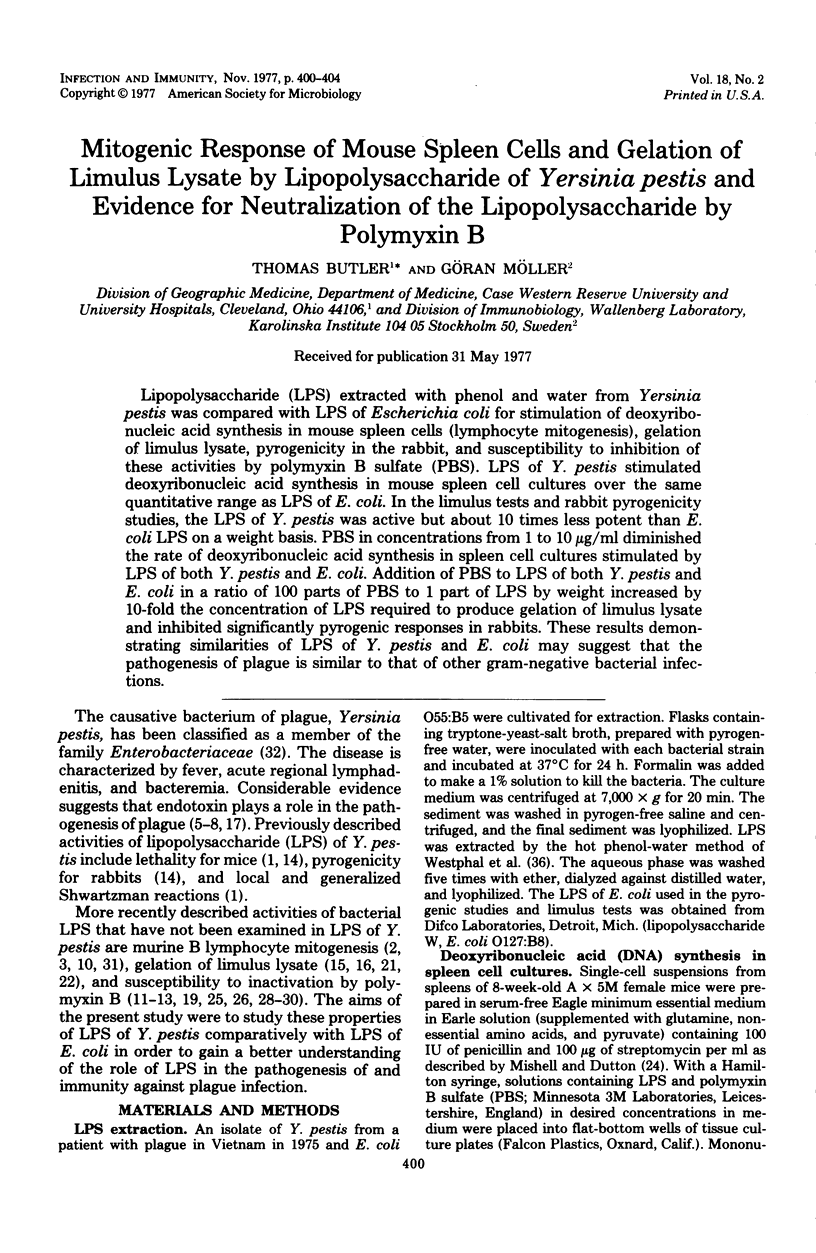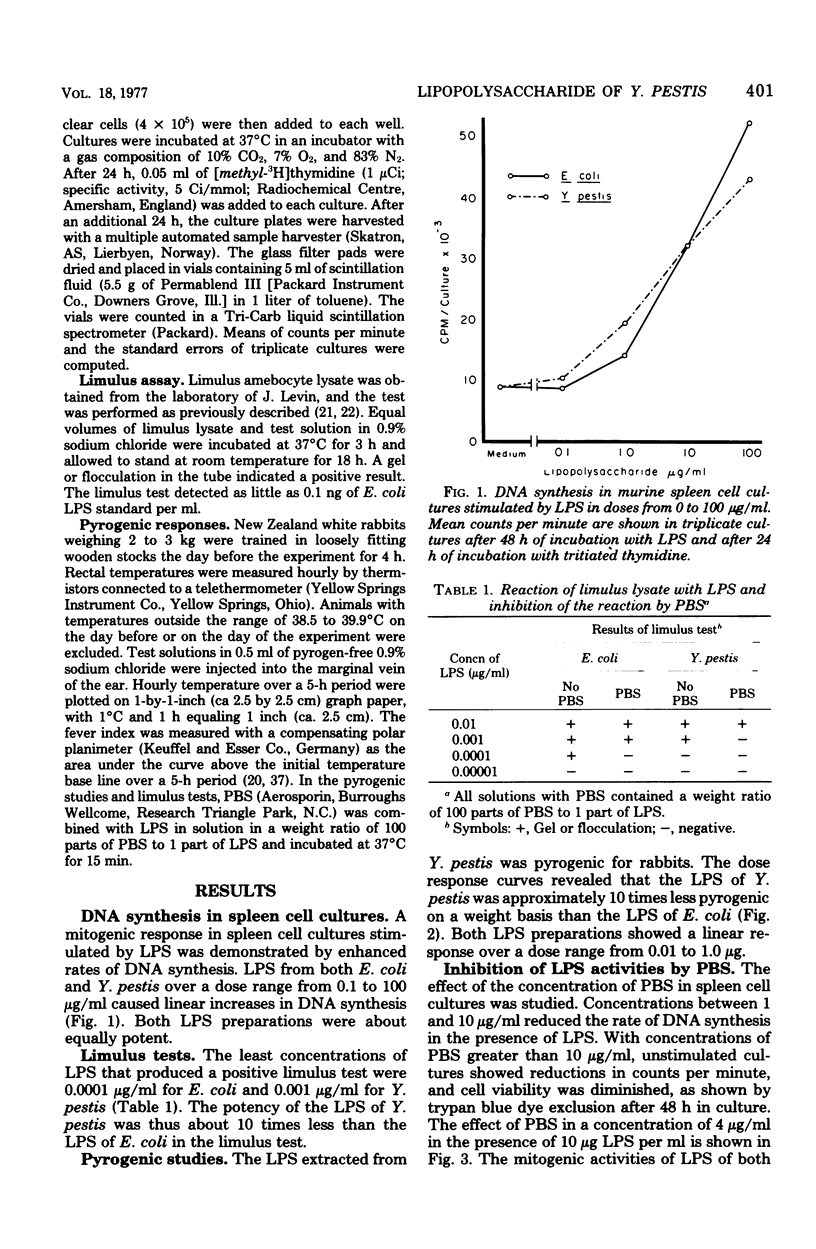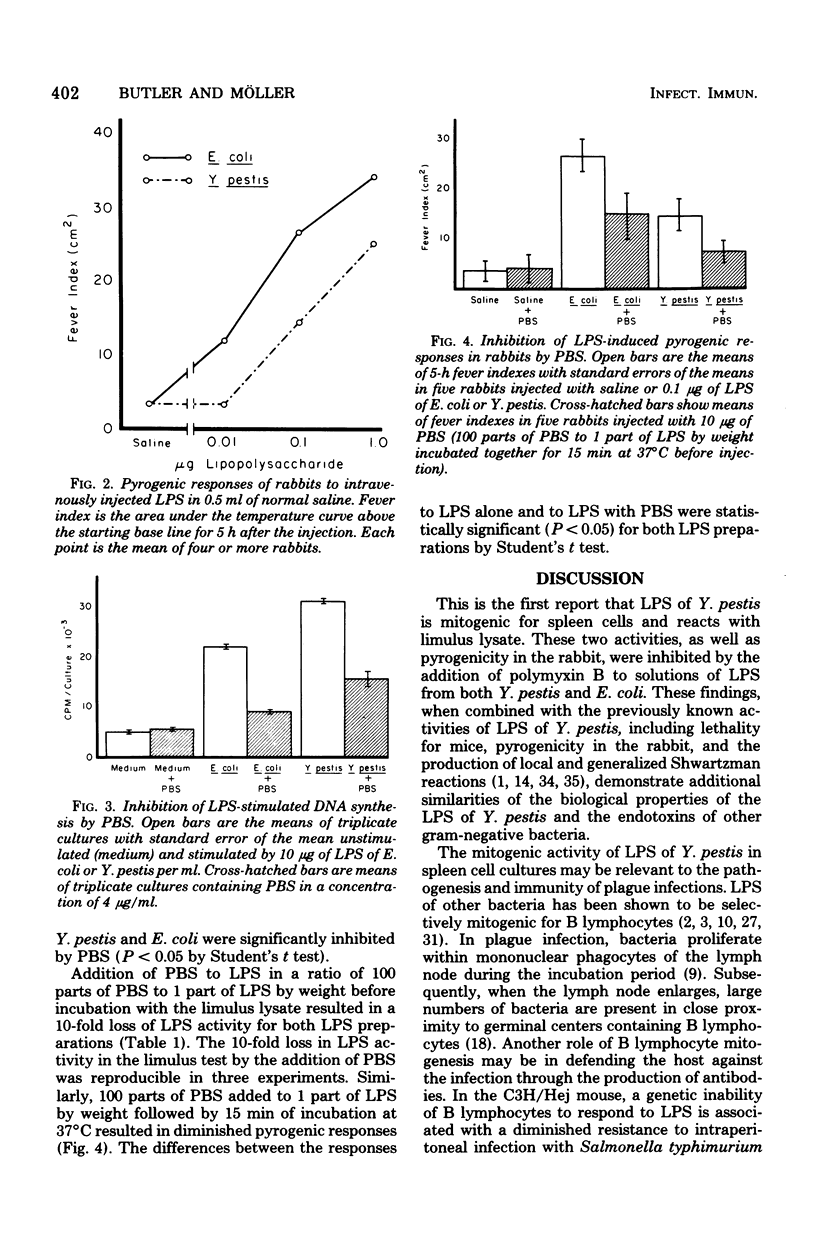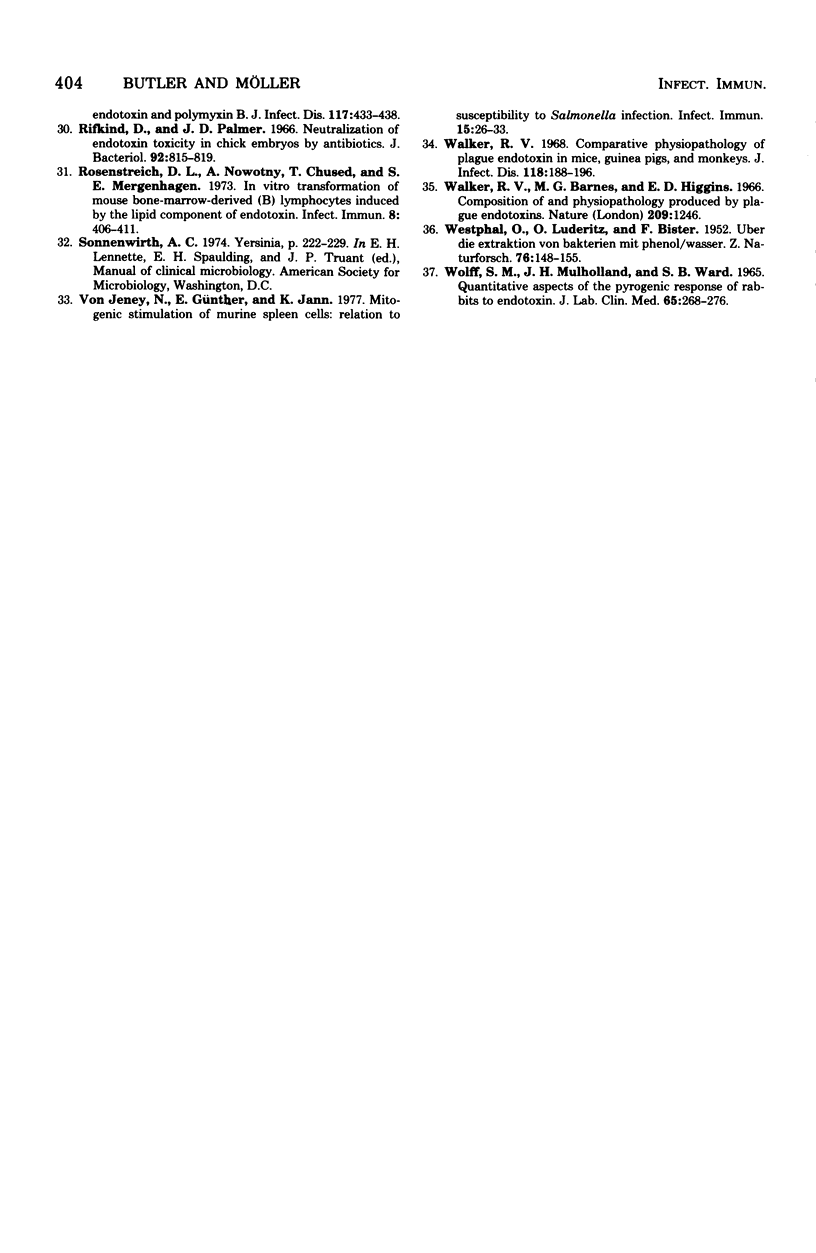Abstract
Lipopolysaccharide (LPS) extracted with phenol and water from Yersinia pestis was compared with LPS of Escherichia coli for stimulation of deoxyribonucleic acid synthesis in mouse spleen cells (lymphocyte mitogenesis), gelation of limulus lysate, pyrogenicity in the rabbit, and susceptibility to inhibition of these activities by polymyxin B sulfate (PBS). LPS of Y. pestis stimulated deoxyribonucleic acid synthesis in mouse spleen cell cultures over the same quantitative range as LPS of E. coli. In the limulus tests and rabbit pyrogenicity studies, the LPS of Y. pestis was active but about 10 times less potent than E. coli LPS on a weight basis. PBS in concentrations from 1 to 10 microgram/ml diminished the rate of deoxyribonucleic acid synthesis in spleen cell cultures stimulated by LPS of both Y. pestis and E. coli. Addition of PBS to LPS of both Y. pestis and E. coli in a ratio of 100 parts of PBS to 1 part of LPS by weight increased by 10-fold the concentration of LPS required to produce gelation of limulus lysate and inhibited significantly pyrogenic responses in rabbits. These results demonstrating similarities of LPS of Y. pestis and E. coli may suggest that the pathogenesis of plague is similar to that of other gram-negative bacterial infections.
Full text
PDF




Selected References
These references are in PubMed. This may not be the complete list of references from this article.
- Albizo J. M., Surgalla M. J. Isolation and Biological Characterization of Pasteurella pestis Endotoxin. Infect Immun. 1970 Sep;2(3):229–236. doi: 10.1128/iai.2.3.229-236.1970. [DOI] [PMC free article] [PubMed] [Google Scholar]
- Andersson J., Melchers F., Galanos C., Lüderitz O. The mitogenic effect of lipopolysaccharide on bone marrow-derived mouse lymphocytes. Lipid A as the mitogenic part of the molecule. J Exp Med. 1973 Apr 1;137(4):943–953. doi: 10.1084/jem.137.4.943. [DOI] [PMC free article] [PubMed] [Google Scholar]
- Andersson J., Möller G., Sjöberg O. Selective induction of DNA synthesis in T and B lymphocytes. Cell Immunol. 1972 Aug;4(4):381–393. doi: 10.1016/0008-8749(72)90040-8. [DOI] [PubMed] [Google Scholar]
- Bader J., Teuber M. Action of polymyxin B on bacterial membranes. 1. Binding to the O-antigenic lipopolysaccharide of Salmonella typhimurium. Z Naturforsch C. 1973 Jul-Aug;28(7):422–430. [PubMed] [Google Scholar]
- Butler T. A clinical study of bubonic plague. Observations of the 1970 Vietnam epidemic with emphasis on coagulation studies, skin histology and electrocardiograms. Am J Med. 1972 Sep;53(3):268–276. doi: 10.1016/0002-9343(72)90168-4. [DOI] [PubMed] [Google Scholar]
- Butler T., Levin J., Do Quang C. u., Walker R. I. Bubonic plague: detection of endotoxemia with the limulus test. Ann Intern Med. 1973 Nov;79(5):642–646. doi: 10.7326/0003-4819-79-5-642. [DOI] [PubMed] [Google Scholar]
- Butler T., Levin J., Linh N. N., Chau D. M., Adickman M., Arnold K. Yersinia pestis infection in Vietnam. II. Quantiative blood cultures and detection of endotoxin in the cerebrospinal fluid of patients with meningitis. J Infect Dis. 1976 May;133(5):493–499. doi: 10.1093/infdis/133.5.493. [DOI] [PubMed] [Google Scholar]
- CAVANAUGH D. C., RANDALL R. The role of multiplication of Pasteurella pestis in mononuclear phagocytes in the pathogenesis of flea-borne plague. J Immunol. 1959 Oct;83:348–363. [PubMed] [Google Scholar]
- Chiller J. M., Skidmore B. J., Morrison D. C., Weigle W. O. Relationship of the structure of bacterial lipopolysaccharides to its function in mitogenesis and adjuvanticity. Proc Natl Acad Sci U S A. 1973 Jul;70(7):2129–2133. doi: 10.1073/pnas.70.7.2129. [DOI] [PMC free article] [PubMed] [Google Scholar]
- Corrigan J. J., Jr, Bell B. M. Comparison between the polymyxins and gentamicin in preventing endotoxin-induced intravascular coagulation and leukopenia. Infect Immun. 1971 Nov;4(5):563–566. doi: 10.1128/iai.4.5.563-566.1971. [DOI] [PMC free article] [PubMed] [Google Scholar]
- Corrigan J. J., Jr, Sieber O. E., Jr, Ratajczak H., Bennett B. B. Modification of human neutrophil response to endotoxin with polymyxin B sulfate. J Infect Dis. 1974 Oct;130(4):384–387. doi: 10.1093/infdis/130.4.384. [DOI] [PubMed] [Google Scholar]
- Craig W. A., Turner J. H., Kunin C. M. Prevention of the generalized Shwartzman reaction and endotoxin lethality by polymyxin B localized in tissues. Infect Immun. 1974 Aug;10(2):287–292. doi: 10.1128/iai.10.2.287-292.1974. [DOI] [PMC free article] [PubMed] [Google Scholar]
- DAVIES D. A. A specific polysaccharide of Pasteurella pestis. Biochem J. 1956 May;63(1):105–116. doi: 10.1042/bj0630105. [DOI] [PMC free article] [PubMed] [Google Scholar]
- Elin R. J., Sandberg A. L., Rosentreich D. L. Comparison of the pyrogenicity, Limulus activity mitogenicity and complement reactivity of several bacterial endotoxins and related compounds. J Immunol. 1976 Oct;117(4):1238–1242. [PubMed] [Google Scholar]
- Elin R. J., Wolff S. M. Nonspecificity of the limulus amebocyte lysate test: positive reactions with polynucleotides and proteins. J Infect Dis. 1973 Sep;128(3):349–352. doi: 10.1093/infdis/128.3.349. [DOI] [PubMed] [Google Scholar]
- Finegold M. J. Pathogenesis of plague. A review of plague deaths in the United States during the last decade. Am J Med. 1968 Oct;45(4):549–554. doi: 10.1016/0002-9343(68)90171-x. [DOI] [PubMed] [Google Scholar]
- Jacobs D. M., Morrison D. C. Inhibition of the mitogenic response to lipopolysaccharide (LPS) in mouse spleen cells by polymyxin B. J Immunol. 1977 Jan;118(1):21–27. [PubMed] [Google Scholar]
- KEENE W. R., SILBERMAN H. R., LANDY M. Observations on the pyrogenic response and its application to the bioassay of endotoxin. J Clin Invest. 1961 Feb;40:295–301. doi: 10.1172/JCI104256. [DOI] [PMC free article] [PubMed] [Google Scholar]
- Levin J., Bang F. B. Clottable protein in Limulus; its localization and kinetics of its coagulation by endotoxin. Thromb Diath Haemorrh. 1968 Mar 31;19(1):186–197. [PubMed] [Google Scholar]
- Levin J., Poore T. E., Zauber N. P., Oser R. S. Detection of endotoxin in the blood of patients with sepsis due to gran-negative bacteria. N Engl J Med. 1970 Dec 10;283(24):1313–1316. doi: 10.1056/NEJM197012102832404. [DOI] [PubMed] [Google Scholar]
- Lopes J., Inniss W. E. Electron microscopy of effect of polymyxin on Escherichia coli lipopolysaccharide. J Bacteriol. 1969 Nov;100(2):1128–1129. doi: 10.1128/jb.100.2.1128-1130.1969. [DOI] [PMC free article] [PubMed] [Google Scholar]
- Mishell R. I., Dutton R. W. Immunization of dissociated spleen cell cultures from normal mice. J Exp Med. 1967 Sep 1;126(3):423–442. doi: 10.1084/jem.126.3.423. [DOI] [PMC free article] [PubMed] [Google Scholar]
- Morrison D. C., Jacobs D. M. Inhibition of lipopolysaccharide-initiated activation of serum complement by polymyxin B. Infect Immun. 1976 Jan;13(1):298–301. doi: 10.1128/iai.13.1.298-301.1976. [DOI] [PMC free article] [PubMed] [Google Scholar]
- Palmer J. D., Rifkind D. Neutralization of the hemodynamic effects of endotoxin by polymyxin B. Surg Gynecol Obstet. 1974 May;138(5):755–759. [PubMed] [Google Scholar]
- Peavy D. L., Adler W. H., Smith R. T. The mitogenic effects of endotoxin and staphylococcal enterotoxin B on mouse spleen cells and human peripheral lymphocytes. J Immunol. 1970 Dec;105(6):1453–1458. [PubMed] [Google Scholar]
- Rifkind D., Palmer J. D. Neutralization of endotoxin toxicity in chick embryos by antibiotics. J Bacteriol. 1966 Oct;92(4):815–819. doi: 10.1128/jb.92.4.815-819.1966. [DOI] [PMC free article] [PubMed] [Google Scholar]
- Rifkind D. Prevention by polymyxin B of endotoxin lethality in mice. J Bacteriol. 1967 Apr;93(4):1463–1464. doi: 10.1128/jb.93.4.1463-1464.1967. [DOI] [PMC free article] [PubMed] [Google Scholar]
- Rifkind D. Studies on the interaction between endotoxin and polymyxin B. J Infect Dis. 1967 Dec;117(5):433–438. doi: 10.1093/infdis/117.5.433. [DOI] [PubMed] [Google Scholar]
- Rosenstreich D. L., Nowotny A., Chused T., Mergenhagen S. E. In vitro transformation of mouse bone-marrow-derived (B) lymphocytes induced by the lipid component of endotoxin. Infect Immun. 1973 Sep;8(3):406–411. doi: 10.1128/iai.8.3.406-411.1973. [DOI] [PMC free article] [PubMed] [Google Scholar]
- WOLFF S. M., MULHOLLAND J. H., WARD S. B. QUANTITATIVE ASPECTS OF THE PYROGENIC RESPONSE OF RABBITS TO ENDOTOXIN. J Lab Clin Med. 1965 Feb;65:268–275. [PubMed] [Google Scholar]
- Walker R. V., Barnes M. G., Higgins E. D. Composition of and physiopathology produced by plague endotoxins. Nature. 1966 Mar 19;209(5029):1246–1246. doi: 10.1038/2091246a0. [DOI] [PubMed] [Google Scholar]
- Walker R. V. Comparative physiopathology of plague endotoxin in mice, guinea pigs and monkeys. J Infect Dis. 1968 Apr;118(2):188–196. doi: 10.1093/infdis/118.2.188. [DOI] [PubMed] [Google Scholar]
- von Jeney N., Günther E., Jann K. Mitogenic stimulation of murine spleen cells: relation to susceptibility to Salmonella infection. Infect Immun. 1977 Jan;15(1):26–33. doi: 10.1128/iai.15.1.26-33.1977. [DOI] [PMC free article] [PubMed] [Google Scholar]


